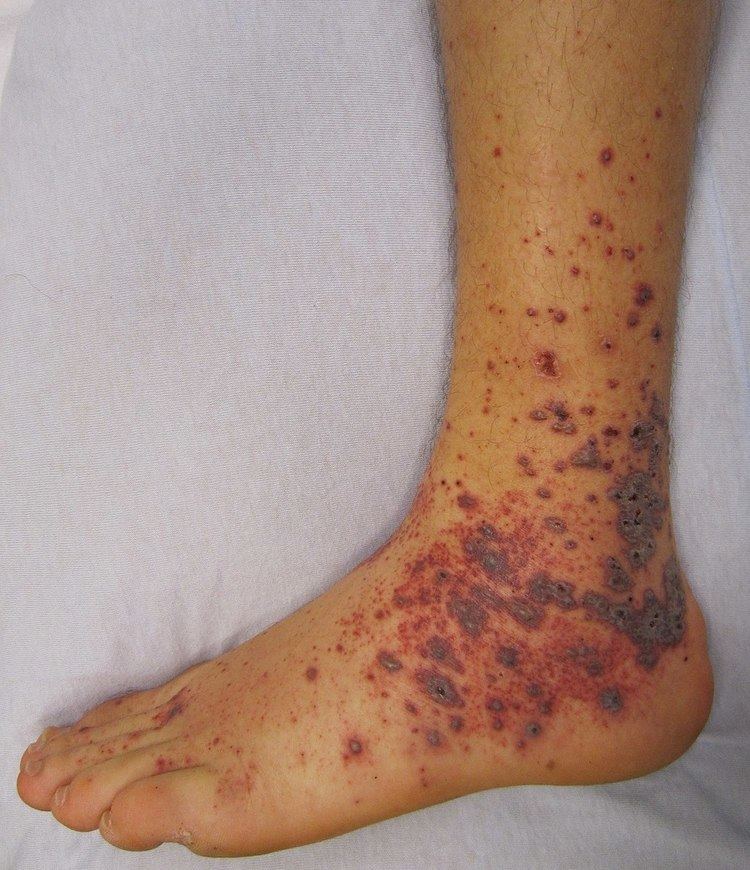Specialty Rheumatology ICD-9-CM 782.7 | ICD-10 R23.3 MeSH D011693 | |
 | ||
Pronunciation petechia /pᵻˈtiːkiə/ petechiae /pᵻˈtiːkiiː/ | ||
A petechia, plural petechiae, is a small (1–2 mm) red or purple spot on the skin, caused by a minor bleed from broken capillary blood vessels.
Contents
- Coughing holding breath vomiting crying
- Constriction Asphyxiation
- Sunburn childbirth weightlifting
- Gua Sha
- Thrombocytopenia
- Kwashiorkor or Marasmus
- Vasculitis
- Meningococcemia
- Forensic science
- References
Petechia refers to one of the three descriptive types of bleeding into the skin differentiated by size, the other two being purpura and ecchymosis. Petechiae are by definition less than 3 mm.
The term is almost always used in the plural, since a single lesion is seldom noticed or significant.
Coughing, holding breath, vomiting, crying
The most common cause of petechiae is through physical trauma such as a hard bout of coughing, holding breath, vomiting or crying, which can result in facial petechiae, especially around the eyes. Petechiae in this instance are harmless and usually disappear within a few days.
Constriction, Asphyxiation
Petechiae may also occur when excessive pressure is applied to tissue (e.g., when a tourniquet is applied to an extremity or with excessive coughing or vomiting).
Sunburn, childbirth, weightlifting
Sunburn, childbirth, weightlifting.
Gua Sha
Gua Sha is a Chinese treatment that scrapes the skin
Thrombocytopenia
Petechiae may be a sign of thrombocytopenia (low platelet counts) when platelet function is inhibited (e.g., as a side effect of medications or during certain infections), or in clotting factor deficiencies.
Kwashiorkor or Marasmus
Childhood protein-energy malnutrition such as Kwashiorkor or Marasmus
Vasculitis
If unsure, petechiae should always be quickly investigated. They can be interpreted as vasculitis, an inflammation of the blood vessels, which requires immediate treatment to prevent permanent damage. Some malignancies can also cause petechiae to appear. Petechiae should be investigated by a doctor to rule out the more dangerous conditions.
Meningococcemia
The significance of petechiae in children depends on the clinical context in which they arise. Petechiae in children can occur with viral infections. In this instance, they do not necessarily signify a serious illness. However, they are a hallmark signal of some potentially serious illnesses, such as meningococcemia, leukemia, and certain causes of thrombocytopenia, of which meningococcemia can cause death within 48 hours of infection. Therefore, their presence should not be ignored.
Petechiae on the soft palate are mainly associated with streptococcal pharyngitis, and as such it is an uncommon but highly specific finding.
Forensic science
Petechiae on the face and conjunctiva (eyes) can be a sign of a death by asphyxiation, particularly when involving reduced venous return from the head (such as in strangulation). Petechiae are thought to result from an increase of pressure in the veins of the head and hypoxic damage to endothelia of blood vessels.
Petechiae can be used by police investigators in determining if strangulation has been part of an attack. The documentation of the presence of petechiae on a victim can help police investigators prove the case. Petechiae resulting from strangulation can be relatively tiny and light in color to very bright and pronounced. Petechiae may be seen on the face, in the whites of the eyes or on the inside of the eyelids.
